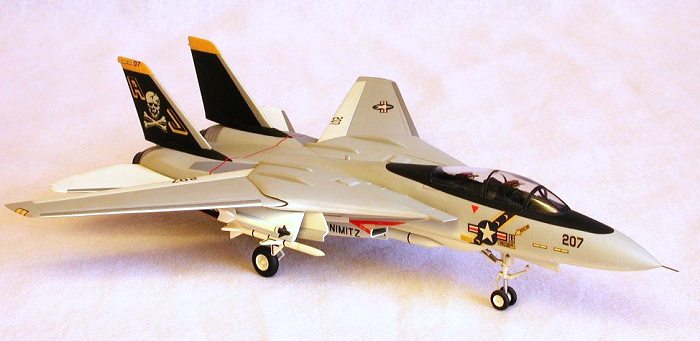
|
KIT: |
Takara 1/100 F-14A Tomcat |
|
KIT # |
6 |
|
PRICE: |
$4.00 about 20 years ago |
|
DECALS: |
Two Aircraft |
|
REVIEW & |
Roger Jackson |
|
NOTES: |
Part of Anime 'Area 88' Series |

|
HISTORY |
With the inevitable demise of the ill-fated F-111B program, the United States Navy embarked on a desperate search to replace its rapidly aging F-4s. Fleet defense is very serious business and, facing a new generation of Soviet stand-off threats, the Navy could ill-afford the luxury of complacency.
Grumman Aircraft Corporation, the prime contractor on the F-111B program, saw the writing on the wall prior to the cancellation of the Navy version of Robert McNamara’s calamity of commonality. When the axe finally fell on the Naval TFX, Grumman engineers were waiting in the wings with a new design specifically tailored as an interceptor.
 The proposal included as
many off-the-shelf components as possible to minimize research and development
time and reduce corporate financial exposure and vulnerability. The most radical
feature of the new aircraft was the variable-sweep wing, though experience with
the TFX program had validated the viability of the concept.
The proposal included as
many off-the-shelf components as possible to minimize research and development
time and reduce corporate financial exposure and vulnerability. The most radical
feature of the new aircraft was the variable-sweep wing, though experience with
the TFX program had validated the viability of the concept.
Grumman proposed using a pair of Pratt & Whitney TF-30-P412 turbofans, though the variable-geometry intakes were designed for a much more powerful engine. The landing gear was lifted en masse from Grumman’s own A-6 Intruder, while the AWG-9 fire control and radar systems were originally developed for the F-111B.
Armament would include the AIM-54 Phoenix missile, radar-guided with an active seeker head allowing true fire-and-forget capability, as well as AIM-7 Sparrows and AIM-9 Sidewinders. For ‘up-close-and-personal’ engagements, General Electric’s six-barreled M-61A1 20 millimeter cannon was available.
The airframe featured tandem seating for the two crewmembers (pilot and radar intercept officer) under a panoramic canopy, twin fins and rudders for more precise yaw control at low speeds, and independent stabilators to accelerate the roll-rate during air combat maneuvers (ACM) and permit minute roll control input changes at high alpha angles.
The airfoil’s variable sweep allowed for superb low-speed handling during shipboard arrestments when fully extended (in conjunction with the flaps and slats), while providing Mach 2+ capability when swept to maximum angle. A bonus was the obviated need for folding wings to facilitate shipboard stowage on crowded flight- and hangar-decks.
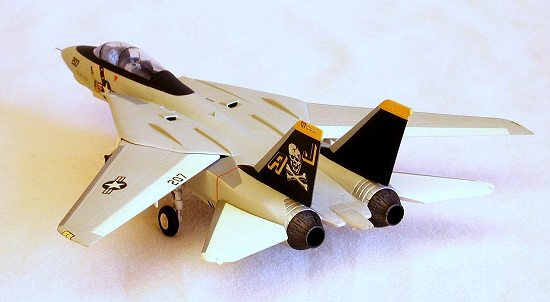 Navy Bureau of
Aeronautics officials were impressed with the new proposal and after a
competitive bidding process involving several other aerospace companies, awarded
Grumman a contract for prototypes in February of 1969. The new interceptor was
designated the F-14, and following the corporate tradition begun with the F4F
Wildcat, was named the Tomcat.
Navy Bureau of
Aeronautics officials were impressed with the new proposal and after a
competitive bidding process involving several other aerospace companies, awarded
Grumman a contract for prototypes in February of 1969. The new interceptor was
designated the F-14, and following the corporate tradition begun with the F4F
Wildcat, was named the Tomcat.
Following flight-testing and carrier suitability trials, the aircraft was ordered into production as the F-14A. Ironically, one of its first operational deployments was providing MIGCAP to U.S. Naval forces assisting in the evacuation of Saigon (RVN) in April of 1975. In another bizarre incident, an F-14 accidentally shot down a USAF RF-4C which had errantly flown into a live-fire missile exercise area over the Mediterranean in the late ‘80s.
Tomcats have served fleet duty worldwide, covering virtually every contingency facing the United States Navy for the last quarter of a century. They’ve bloodied the Libyan Air Force’s nose on more than one occasion and contributed in no small measure to the defeat of Iraqi forces during the Gulf Was and the continued containment of Sadaam’s aspirations.
F-14s will soon be supplanted by the F/A-18E/F Super Hornet as the Tomcat airframes reach the end of their useful service lives. However, no replacement for the AIM-54 Phoenix missile (with its 100+ mile range) has of yet been certified for carriage or even designed for the new Hornet. The Grumman "Turkey’s" departure will undoubtedly leave big shoes to fill.
|
THE KIT |
Takara’s F-14A Tomcat kit consists of 76 light gray parts, a canopy and two-piece display stand molded in clear, and a large (approximately 1/24th scale) caricature of a pilot figure. The minimal text in the instruction sheet is in Japanese and contains basic painting directions (presumably geared to Revell/Takara colors) and a decal placement guide.
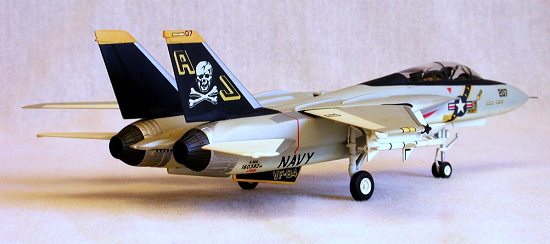 Surface detail is fully
recessed and correctly depicts the Tomcat’s panel lines and various movable
control surfaces. The wings feature geared tabs designed to intermesh with one
another, thus providing the kit’s only operational option—the variable-sweep
wing.
Surface detail is fully
recessed and correctly depicts the Tomcat’s panel lines and various movable
control surfaces. The wings feature geared tabs designed to intermesh with one
another, thus providing the kit’s only operational option—the variable-sweep
wing.
An extensive external ordnance fit is provided, consisting of 2 Sidewinder, 4 Phoenix, and 6 Sparrow missiles with the proper pylons and pallets for carriage. Two auxiliary fuel tanks are also furnished for use.
The cockpit assembly is somewhat sparse, containing two seats and a cockpit tub. Decals are used to represent the instrument panels and side consoles while two seated pilot figures are included. The one-piece canopy is extremely clear with the framing correctly depicted.
The landing gear is well-detailed for the scale and includes all the doors extant on the prototype, though the oleo-strut is excessively extended for the nosewheel. The doors for the nose well are molded integral with the forward fuselage halves, thus simplifying the assembly.
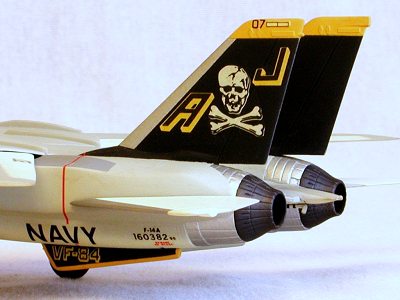 The one-piece intake ducts
feature separate fan fronts, while the tailpipes are crisply molded in the
fully-constricted configuration with separate afterburner inserts for each. The
tailhook and ventral fins are individually molded as well.
The one-piece intake ducts
feature separate fan fronts, while the tailpipes are crisply molded in the
fully-constricted configuration with separate afterburner inserts for each. The
tailhook and ventral fins are individually molded as well.
A two-piece stand is available as an option, along with four ground crew figures and a simulated section of tarmac printed on the inside of the box top for use as a diorama display base. The large cartoon figure provided is apparently a character in the Japanese Anime show from which this model and others in the set were derived (I wish it were on here in the States).
Decals are consistent with the quality of typical Tamiya/Hasegawa/Fujimi/Otaki sheets: matte-finished and slightly translucent. Markings are included for the fictitious "Royal Aslan Air Force", and a full-color U. S. Navy VF-84 scheme from the U.S.S. Nimitz circa 1980. The fuselage bands for this aircraft are incorrectly printed in insignia blue.
|
CONSTRUCTION |
Assembly of this model was the closest I’ve come to a box-shaker in many a year. The variable-geometry wings were pinned in a stationary position at about the mid-sweep point as these juvenile operating features invariably lead to paint and finishing problems.
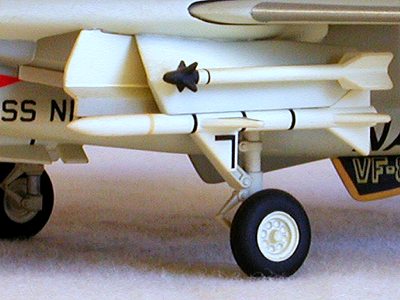 Other than bulletproofing
the pitot tube by substitution of a straight pin, drilling out the gun port, and
adding grab-rings to the ejection seats, I followed the recommended steps in the
instruction sheet to the letter.
Other than bulletproofing
the pitot tube by substitution of a straight pin, drilling out the gun port, and
adding grab-rings to the ejection seats, I followed the recommended steps in the
instruction sheet to the letter.
The canopy fit well enough that I used Elmer’s white glue to attach it, eliminating the need for filling, sanding or polishing. The landing gear was somewhat fiddly, due to the small size of the parts, but sturdy enough to support the completed model.
Though I added ballast to the nose, the airplane teetered dangerously close to tail-dragger status. To alleviate this situation I glued some additional lead weight inside the nose wheel well, carefully disguised to appear as part of the structure.
The stabilators were installed using brass wire pins to eliminate potential problems with adhesives and inherent joint clean-up operations. Pins were also used to affix the Phoenix missiles to their pallets.
After a careful sanding of all assembly seams and clean-up of some molding irregularities on the missiles, it was off to the paint shop.
|
PAINT & DECALS |
The standard gull gray (FS36440) over white finish was applied using Modelmaster enamels. When dry, I masked the cockpit glass and laid out the anti-glare panel on the nose. Flat black was used here as well as on the vertical fins and outside surfaces of the ventral fins. Yellow was used on the fin tips and as edging on the black areas of the ventral fins.
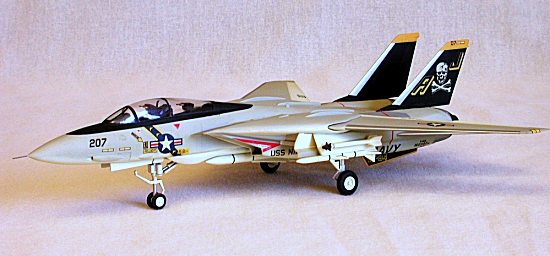 The tires, tailpipes, and
un-painted areas of the aft fuselage were brush-painted in the appropriate
colors, while dark gull gray (FS 36231) decal material was used for the wing
walk and over-sweep areas on top of the fuselage.
The tires, tailpipes, and
un-painted areas of the aft fuselage were brush-painted in the appropriate
colors, while dark gull gray (FS 36231) decal material was used for the wing
walk and over-sweep areas on top of the fuselage.
After adding some decal details to the missiles and attaching them I decaled the rest of the model, using the kit-supplied alternate VF-84 scheme. The bare-metal areas on the leading edges of the flying surfaces were simulated with strips of silver decal. When dry, I washed the model thoroughly and sprayed several coats of Testor’s flat lacquer to seal the finish.
|
CONCLUSIONS |
This diminutive F-14 has a charm all its own, and due to the sub-Smurf scale, represents a lesser commitment of time and resources than do max-effort masterpieces in the larger sizes. The model’s lines and shape look good however, and the overall detail and number of parts rivals larger-scale releases from Monogram and Revell.
 I found this kit (and a
number of others in the set) at Brookhurst Hobbies in Garden Grove, California
during a mission to perform ‘best man’ duties at a friend’s wedding
(again!). I bought every one they had including an A-10, F-100, F-8E, and an
F-5G (F-20). Other aircraft in the set are a Kfir, A-6E, A-7, and an F-111E,
though I haven’t personally seen the Aardvark. (Editor's Note: you can add
a Yak-36 Forger and A-4M to this list)
I found this kit (and a
number of others in the set) at Brookhurst Hobbies in Garden Grove, California
during a mission to perform ‘best man’ duties at a friend’s wedding
(again!). I bought every one they had including an A-10, F-100, F-8E, and an
F-5G (F-20). Other aircraft in the set are a Kfir, A-6E, A-7, and an F-111E,
though I haven’t personally seen the Aardvark. (Editor's Note: you can add
a Yak-36 Forger and A-4M to this list)
Upon examining the contents of the Tomcat kit I immediately noted the VF-84 decals. Sirens wailed, lights began to blink, and the wheels started turning… The small-but-sturdy F-14 would make an excellent fly-along companion when watching "The Final Countdown"! A Japanese ‘meatball’ was dutifully applied to the portside canopy rail to reflect this model’s singular mission.
Rest assured, whenever the movie is shown on the late show, I’m flying a tight two-ship with Commander Emory Brown as Captain Yellen tersely orders us to "Splash the Zekes…I say again, splash the Zekes". We snap-roll inverted and execute a split-S in unison while the pipper on my HUD swiftly cues up for a missile lock and the IR annunciator growls in my ear. The hapless son of Nippon futilely attempts a side-slip maneuver, totally oblivious to the all-aspect capability of the AIM-9L. "I got tone, I got tone…fox two…missile away!"
|
REFERENCE |
F-14 Tomcat In Action - Lou Drendel; Squadron-Signal Publications
Top Gun: The Navy’s Fighter Weapons School - George Hall; Presidio Press
CV: Carrier Aviation - Peter Garrison & George Hall; Presidio Press
The Encyclopedia Of World Air Power - Bill Gunston; Crescent Books
The Cutting Edge - C. J. Heatley III; Thomasson, Grant & Howell Publishing

Ó May 2001 by Roger M. Jackson
First Time North American Rights To Scott VanAken and ‘Modeling Madness’
If you would like your product reviewed fairly and quickly by a site that averages over 2,700 visits a day, please contact me or see other details in the Note to Contributors.